Tolerance to Drought and Water Stress Resistance Mechanism of Castor Bean
Abstract
:1. Introduction
2. Materials and Methods
2.1. Soil
2.2. Experimental Setup
2.3. Treatments
2.4. Measurements
2.5. Statistical Analysis
3. Results and Discussion
4. Conclusions
Author Contributions
Funding
Conflicts of Interest
References
- Turner, K.; Georgiou, S.; Clark, R.; Brouwer, R.; Burke, J. Economic Valuation of Water Resources in Agriculture: From the Sectoral to a Functional Perspective of Natural Resource Management; FAO: Rome, Italy, 2004; ISBN 92-5-105190-9. [Google Scholar]
- Iglesias, A.; Quiroga, S.; Diz, A. Looking into the future of agriculture in a changing climate. Eur. Rev. Agric. Econ. 2011, 38, 427–447. [Google Scholar] [CrossRef]
- Wada, Y.; Bierkens, M.F.P. Sustainability of global water use: Past reconstruction and future projections. Environ. Res. Lett. 2014, 9, 104003. [Google Scholar] [CrossRef]
- Iglesias, A.; Garrote, L. Adaptation strategies for agricultural water management under climate change in Europe. Agric. Water Manag. 2015, 155, 113–124. [Google Scholar] [CrossRef] [Green Version]
- Lesk, C.; Rowhani, P.; Ramankutty, N. Influence of extreme weather disasters on global crop production. Nature 2016, 529, 84–87. [Google Scholar] [CrossRef]
- Huang, Z.; Hejazi, M.; Tang, Q.; Vernon, C.R.; Liu, Y.; Chen, M.; Calvin, K. Global agricultural green and blue water consumption under future climate and land use changes. J. Hydrol. 2019, 574, 242–256. [Google Scholar] [CrossRef]
- Teotonio, C.; Rodriguez, M.; Roebeling, P.; Fortes, P. Water competition through the ‘water-energy’ nexus: Assessing the economic impacts of climate change in a Mediterranean context. Energy Econ. 2019, 85, 104539. [Google Scholar] [CrossRef]
- Perry, B.A. Chromosome number and phylogenetic relationships in the Euphorbiaceae. Am. J. Bot. 1943, 30, 527–543. [Google Scholar] [CrossRef]
- Anjani, K. Castor genetic resources: A primary gene pool for exploitation. Ind. Crops Prod. 2012, 35, 1–14. [Google Scholar] [CrossRef]
- Singh, A.S.; Kumari, S.; Modi, A.R.; Gajera, B.B.; Narayanan, S.; Kumar, N. Role of conventional and biotechnological approaches in genetic improvement of castor (Ricinus communis L.). Ind. Crops Prod. 2015, 74, 55–62. [Google Scholar] [CrossRef]
- Falasca, S.; Ulberich, A.C.; Ulberich, E. Developing an agro-climatic zoning model to determine potential production areas for castor bean (Ricinus communis L.). Ind. Crops Prod. 2012, 40, 185–191. [Google Scholar] [CrossRef]
- Alexopoulou, E.; Papatheohari, Y.; Zanetti, F.; Tsiotas, K.; Papamichael, I.; Christou, M.; Namatov, I.; Monti, A. Comparative studies on several castor (Ricinus communis L.) hybrids: Growth, yields, seed oil and biomass characterization. Ind. Crops Prod. 2015, 75, 8–13. [Google Scholar] [CrossRef]
- Patanè, C.; Cosentino, S.L.; Corinzia, S.A.; Testa, G.; Sortino, O.; Scordia, D. Photothermal zoning of castor (Ricinus communis L.) growing season in the semi-arid Mediterranean area. Ind. Crops Prod. 2019, 142, 111837. [Google Scholar] [CrossRef]
- Scholz, V.; da Silva, J.N. Prospects and risks of the use of castor oil as a fuel. Biomass Bioenergy 2008, 32, 95–100. [Google Scholar] [CrossRef]
- Sbihi, H.M.; Nehdi, I.A.; Mokbli, S.; Romdhani-Younes, M.; Al-Resayes, S.I. Hexane and ethanol extracted seed oils and leaf essential compositions from two castor plant (Ricinus communis L.) varieties. Ind. Crops Prod. 2018, 122, 174–181. [Google Scholar] [CrossRef]
- Severino, L.S.; Auld, D.L.; Baldanzi, M.; Cândido, M.J.D.; Chen, G.; Crosby, W.; Tan, D.; He, X.; Lakshmamma, P.; Lavanya, C.; et al. A Review on the Challenges for Increased Production of Castor. Agron. J. 2012, 104, 853–880. [Google Scholar] [CrossRef] [Green Version]
- Zanetti, F.; Chieco, C.; Alexopoulou, E.; Vecchi, A.; Bertazza, G.; Monti, A. Comparison of new castor (Ricinus communis L.) genotypes in the Mediterranean area and possible valorization of residual biomass for insect rearing. Ind. Crops Prod. 2017, 107, 581–587. [Google Scholar] [CrossRef]
- Carvalho, M.; Roza, F.A.; Mielke, M.S.; Furtado de Almeida, A.A.; Gomes, L.M.C. Ricinus communis L.: Water Use Efficiency, Carbon Assimilation and Water Relations on Deficit Irrigation. J. Exp. Agric. Int. 2019, 30, 1–15. [Google Scholar] [CrossRef]
- Glaser, L.K.; Roetheli, J.C.; Thompson, A.E.; Brigham, R.D.; Carlson, K.D. Castor and Lesquerella: Sources of hydroxy fatty acids. In Yearbook of Agriculture; USDA Office Publishing Visual Communication: Washington, DC, USA, 1993; pp. 111–117. [Google Scholar]
- Ogunniyi, D.S. Castor oil: A vital industrial raw material. Bioresour. Technol. 2006, 97, 1086–1091. [Google Scholar] [CrossRef]
- Dubois, J.L.; Piccirilli, A.; Magne, J.; He, X. Detoxification of castor meal through reactive seed crushing. Ind. Crops Prod. 2013, 43, 194–199. [Google Scholar] [CrossRef]
- Wu, W.X.; Li, J.; Yang, X.L.; Wang, N.; Yu, X.Q. Lipase-catalyzed synthesis of renewable acid-degradable poly(β-thioetherester) and poly(β-thioether ester-co-ricinoleic acid) copolymers derived from castor oil. Eur. Polym. J. 2019, 121, 109315. [Google Scholar] [CrossRef]
- Naseem, M.; Sadaf, S.; Bibi, S.; Rehman, H.U.; Hassan, M.U.; Aziz, S.; Ullah, I. Evaluation of a NIAB Gold castor variety for biodiesel production and bio-pesticide. Ind. Crops Prod. 2019, 130, 634–641. [Google Scholar] [CrossRef]
- FAOSTAT. 2017. Available online: http://www.fao.org/faostat/en/#data/QC/visualize (accessed on 14 September 2020).
- Lavanya, C.; Murthy, I.Y.L.N.; Nagaraj, G.; Mukta, N. Prospects of castor (Ricinus communis L.) genotypes for biodiesel production in India. Biomass Bioenergy 2012, 39, 204–209. [Google Scholar] [CrossRef]
- Patel, V.R.; Dumancas, G.G.; Viswanath, L.C.K.; Maples, R.; Subong, B.J.J. Castor Oil: Properties, Uses, and Optimization of Processing Parameters in Commercial Production. Lipid Insights 2016, 9, LPI-S40233. [Google Scholar] [CrossRef] [Green Version]
- Koutroubas, S.D.; Papakosta, D.K.; Doitsidis, A. Adaptation and yielding ability of castor plant (Ricinus communis L.) genotypes in a Mediterranean climate. Eur. J. Agron. 1999, 11, 227–237. [Google Scholar] [CrossRef]
- Koutroubas, S.D.; Papakosta, D.K.; Doitsinis, A. Water requirements for castor oil crop (Ricinus communis L.) in a Mediterranean climate. J. Agron. Crop Sci. 2000, 184, 33–41. [Google Scholar] [CrossRef]
- Laureti, D.; Marras, G. Irrigation of castor (Ricinus communis L.) in Italy. Eur. J. Agron. 1995, 4, 229–235. [Google Scholar] [CrossRef]
- Day, P.R. Particle fractionation and particle-size analysis. In Methods of Soil Analysis, Part 1. Physical and Mineralogical Properties, Including Statistics of Measurements and Sampling; Black, C.A., Ed.; American Society of Agronomy and the Soil Science Society of America: Madison, WI, USA, 1965; pp. 545–567. [Google Scholar]
- Nelson, D.W.; Sommers, L.E. Total carbon, organic carbon, and organic matter. In Methods of Soil Analysis, Part 2. Chemical and Microbiological Properties, 2nd ed.; Page, A.L., Miller, R.H., Keeney, D.R., Eds.; American Society of Agronomy and the Soil Science Society of America Madison: Madison, WI, USA, 1982; Volume 9, pp. 539–579. [Google Scholar]
- Rowell, D.L. Soil Science: Methods & Applications; Longman Group: London, UK, 1997. [Google Scholar]
- Chaudhary, P.; Godara, S.; Cheeran, A.N.; Chaudhari, A.K. Fast and Accurate Method for Leaf Area Measurement. Int. J. Comput. Appl. 2012, 49, 22–25. [Google Scholar] [CrossRef]
- Osakabe, Y.; Osakabe, K.; Shinozaki, K.; Tran, L.S.P. Response of plants to water stress. Front. Plant Sci. 2014, 5, 86. [Google Scholar] [CrossRef] [Green Version]
- Booker, J.; Trees, W.S. Implications of Water Scarcity for Water Productivity and Farm Labor. Water 2020, 12, 308. [Google Scholar] [CrossRef] [Green Version]
- Nilsen, E.T.; Orcutt, D.M. Physiology of Plants under Stress: Abiotic Factors; John Wiley and Sons: Toronto, ON, Canada, 1996. [Google Scholar]
- Fathi, A.; Tari, D.B. Effect of Drought Stress and its Mechanism in Plants. Int. J. Life Sci. 2016, 10, 1–6. [Google Scholar] [CrossRef] [Green Version]
- Tombesi, S.; Frioni, T.; Poni, S.; Palliotti, A. Effect of water stress “memory” on plant behavior during subsequent drought stress. Environ. Exp. Bot. 2018, 150, 106–114. [Google Scholar] [CrossRef]
- Yates, S.; Jaskune, K.; Liebisch, F.; Nagelmuller, S.; Kirchgessner, N.; Kolliker, R.; Walter, A.; Brazauskas, G.; Studer, B. Phenotyping a Dynamic Trait: Leaf Growth of Perennial Ryegrass Under Water Limiting Conditions. Front. Plant Sci. 2019, 10, 344. [Google Scholar] [CrossRef] [PubMed]
- Karabourniotis, G. Stress Physiology of Plants; Embryo Publications: Athens, Greece, 2003. [Google Scholar]
- Kar, R.K. Plant responses to water stress. Plant Signal. Behav. 2011, 6, 1741–1745. [Google Scholar] [CrossRef] [PubMed] [Green Version]
- Poorter, H.; Niklas, K.J.; Reich, P.B.; Oleksyn, J.; Poot, P.; Mommer, L. Biomass allocation to leaves, stems and roots: Meta-Analyses of interspecific variation and environmental control. New Phytol. 2012, 193, 30–50. [Google Scholar] [CrossRef] [PubMed]
- Catoni, R.; Gratani, L.; Bracco, F.; Granata, M.U. How water supply during leaf development drives water stress response in Corylus avellana saplings. Sci. Hortic. 2017, 214, 122–132. [Google Scholar] [CrossRef]
- Zhou, H.; Zhou, G.; He, Q.; Zhou, L.; Ji, Y.; Zhou, M. Environmental explanation of maize specific leaf area under varying water stress regimes. Environ. Exp. Bot. 2020, 171, 103932. [Google Scholar] [CrossRef]
- Severino, L.S.; Auld, D.L. A framework for the study of the growth and development of castor plant. Ind. Crops Prod. 2013, 46, 25–38. [Google Scholar] [CrossRef]
- Severino, L.S.; Cardoso, G.D.; Vale, L.S.; Santos, J.W. A method for castor bean leaf estimation. Rev. Bras. Oleaginosas Fibrosas 2004, 8, 753–762. [Google Scholar]
- Lima, R.L.S.; Severino, L.S.; Silva, M.I.L.; Vale, L.S.; Beltrao, N.E.M. Recipients volume and substrate composition for castor seedlings production. Cienc. Agrotecnol. 2006, 30, 480–486. [Google Scholar] [CrossRef]
- Guerfel, M.; Baccouri, O.; Boujnah, D.; Chaibi, W.; Zarrouk, M. Impacts of water stress on gas exchange, water relations, chlorophyll content and leaf structure in the two main Tunisian olive (Olea europaea L.) cultivars. Sci. Hortic. 2009, 119, 257–263. [Google Scholar] [CrossRef]
- Sausen, T.L.; Rosa, M.G. Growth and carbon assimilation limitations in Ricinus communis (Euphorbiaceae) under soil water stress conditions. Acta Bot. Bras. 2010, 24, 648–654. [Google Scholar] [CrossRef]
- Fanourakis, D.; Bouranis, D.; Giday, H.; Carvalho, D.R.A.; Nejad, A.R.; Ottosen, C.O. Improving stomatal functioning at elevated growth air humidity: A review. J. Plant Physiol. 2016, 207, 51–60. [Google Scholar] [CrossRef] [PubMed]
- Elliott-Kingston, C.; Haworth, M.; Yearsley, J.M.; Batke, S.P.; Lawson, T.; McElwain, J.C. Does Size Matter? Atmospheric CO2 may be a stronger driver of stomatal closing rate than stomatal size in taxa that diversified under low CO2. Front. Plant Sci. 2016, 7, 1253. [Google Scholar] [CrossRef] [PubMed] [Green Version]
- Haworth, M.; Scutt, C.P.; Douthe, C.; Marino, G.; Gomes, M.T.G.; Loreto, F.; Flexas, J.; Centritto, M. Allocation of the epidermis to stomata relates to stomatal physiological control: Stomatal factors involved in the evolutionary diversification of the angiosperms and development of amphistomaty. Environ. Exp. Bot. 2018, 151, 55–63. [Google Scholar] [CrossRef]
- Hedrich, R.; Shabala, S. Stomata in a saline world. Curr. Opin. Plant Biol. 2018, 46, 87–95. [Google Scholar] [CrossRef]
- Buckley, T.N. How do stomata respond to water status? New Phytol. 2019, 224, 21–36. [Google Scholar] [CrossRef] [Green Version]
- Cannavo, P.; Ali, H.B.; Chantoiseau, E.; Migeon, C.; Charpentier, S.; Bournet, P.E. Stomatal resistance of New Guinea Impatiens pot plants. Part 2: Model extension for water restriction and application to irrigation scheduling. Biosyst. Eng. 2016, 149, 82–93. [Google Scholar] [CrossRef]
- Sandoval, D.; Rada, F.; Sarmiento, L. Stomatal response functions to environmental stress of dominant species in the tropical Andean páramo. Plant Ecol. Divers. 2019, 12, 649–661. [Google Scholar] [CrossRef]
- Nikneshan, P.; Tadayyon, A.; Javanmard, M. Evaluating drought tolerance of castor ecotypes in the center of Iran. Heliyon 2019, 5, e01403. [Google Scholar] [CrossRef] [Green Version]
- Chaves, M.M.; Flexas, J.; Pinheiro, C. Photosynthesis under drought and salt stress: Regulation mechanisms from whole plant to cell. Ann. Bot. 2009, 103, 551–560. [Google Scholar] [CrossRef] [Green Version]
- Lawlor, D.W.; Tezara, W. Causes of decreased photosynthetic rate and metabolic capacity in water-deficient leaf cells: A critical evaluation of mechanisms and integration of processes. Ann. Bot. 2009, 103, 561–579. [Google Scholar] [CrossRef] [PubMed] [Green Version]
- Higgs, K.H.; Jones, H.G. Response of apple rootstocks to irrigation in southeast England. J. Hortic. Sci. 1990, 65, 129–141. [Google Scholar] [CrossRef]
- Higgs, K.H.; Jones, H.G. Water relations and cropping of apple cultivars on a dwarfing rootstock in response to imposed drought. J. Hortic. Sci. 1991, 66, 36. [Google Scholar] [CrossRef]
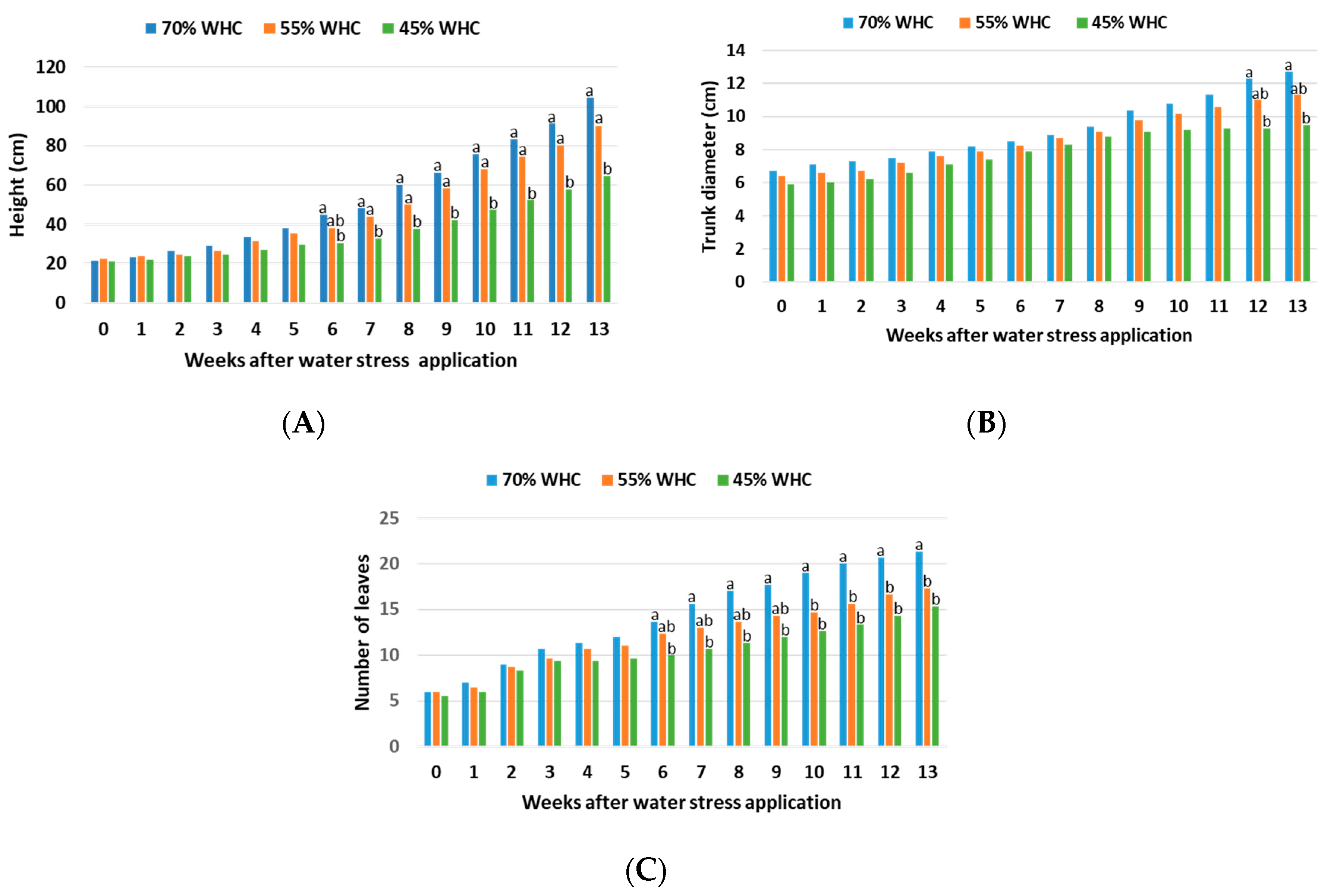
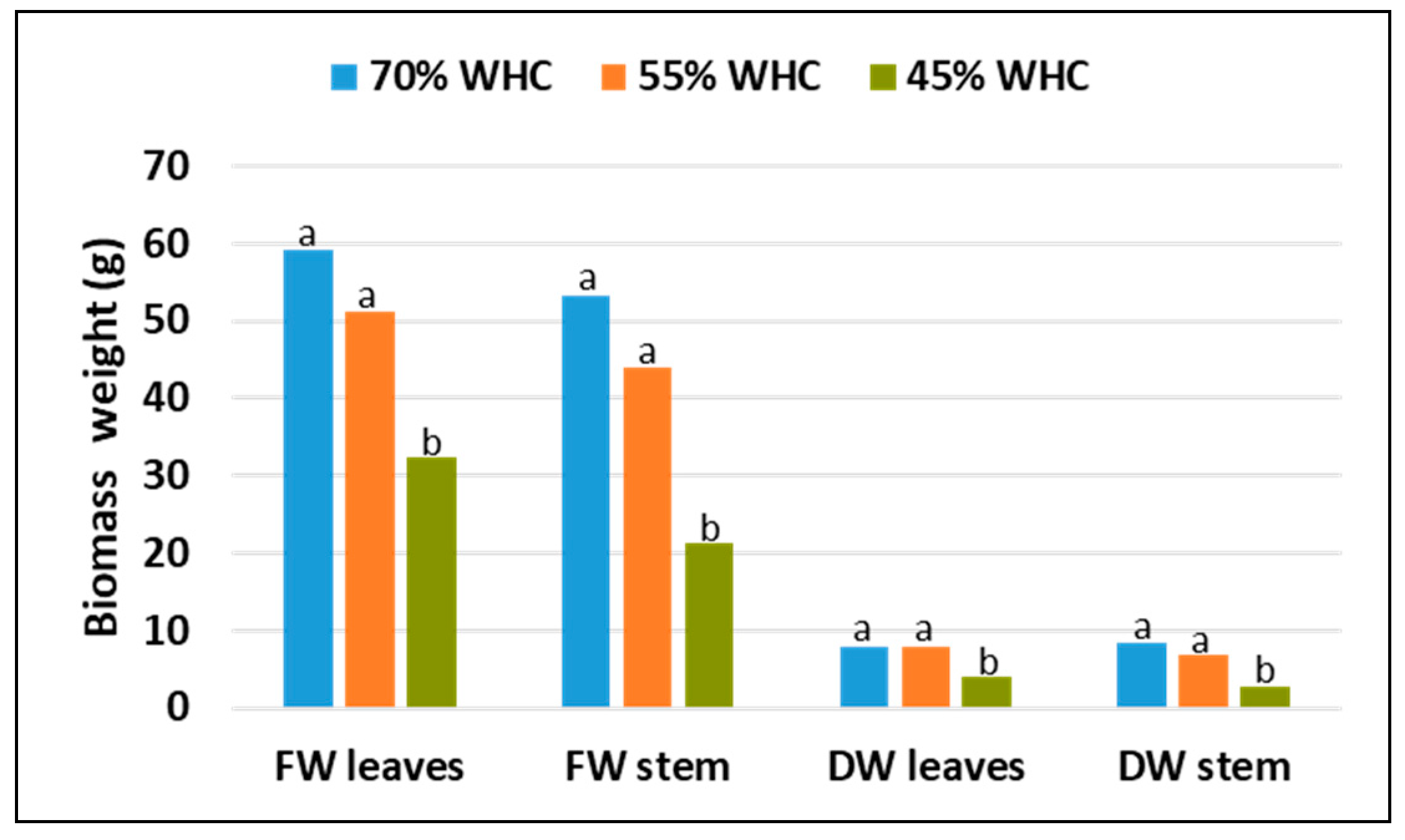
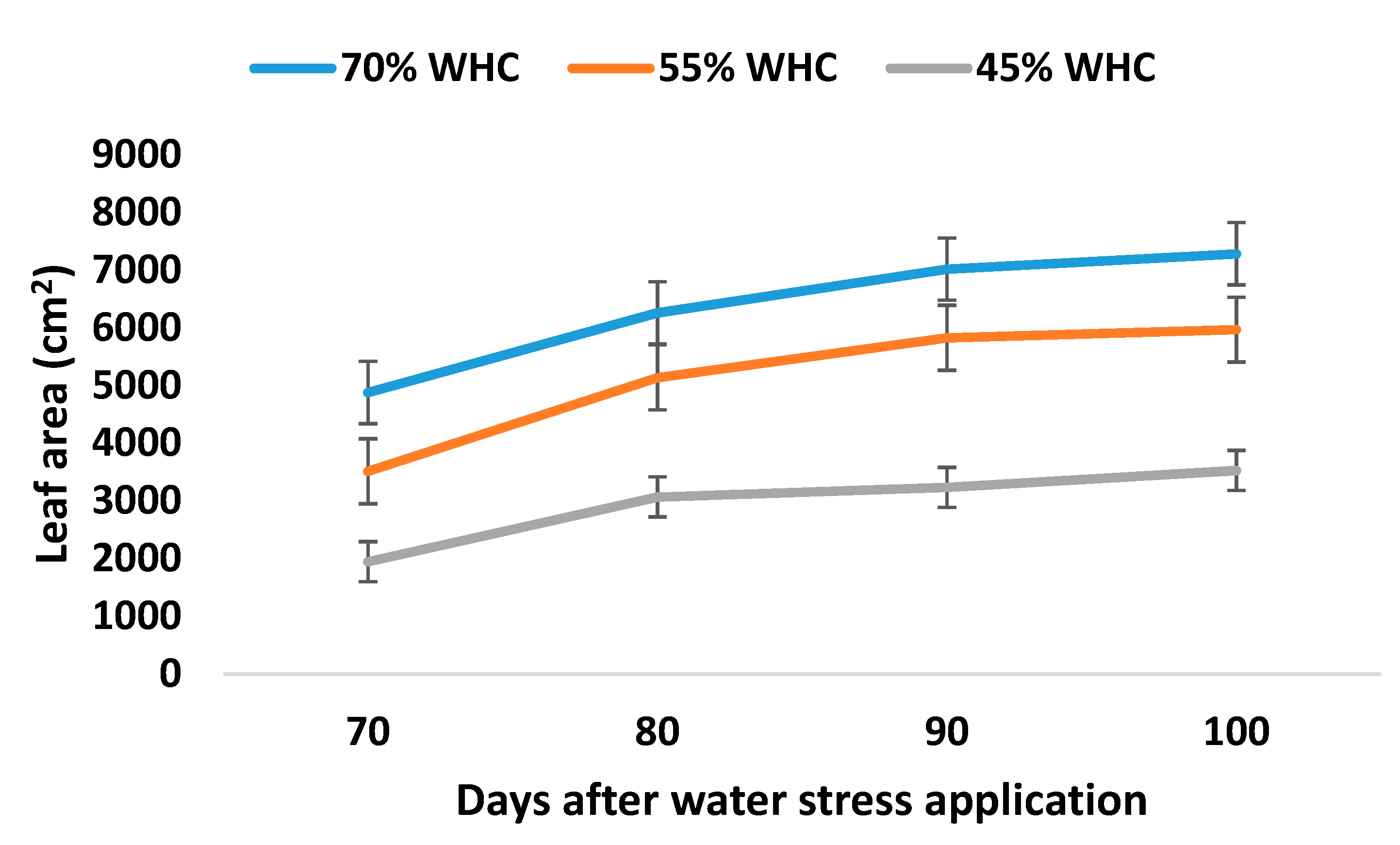
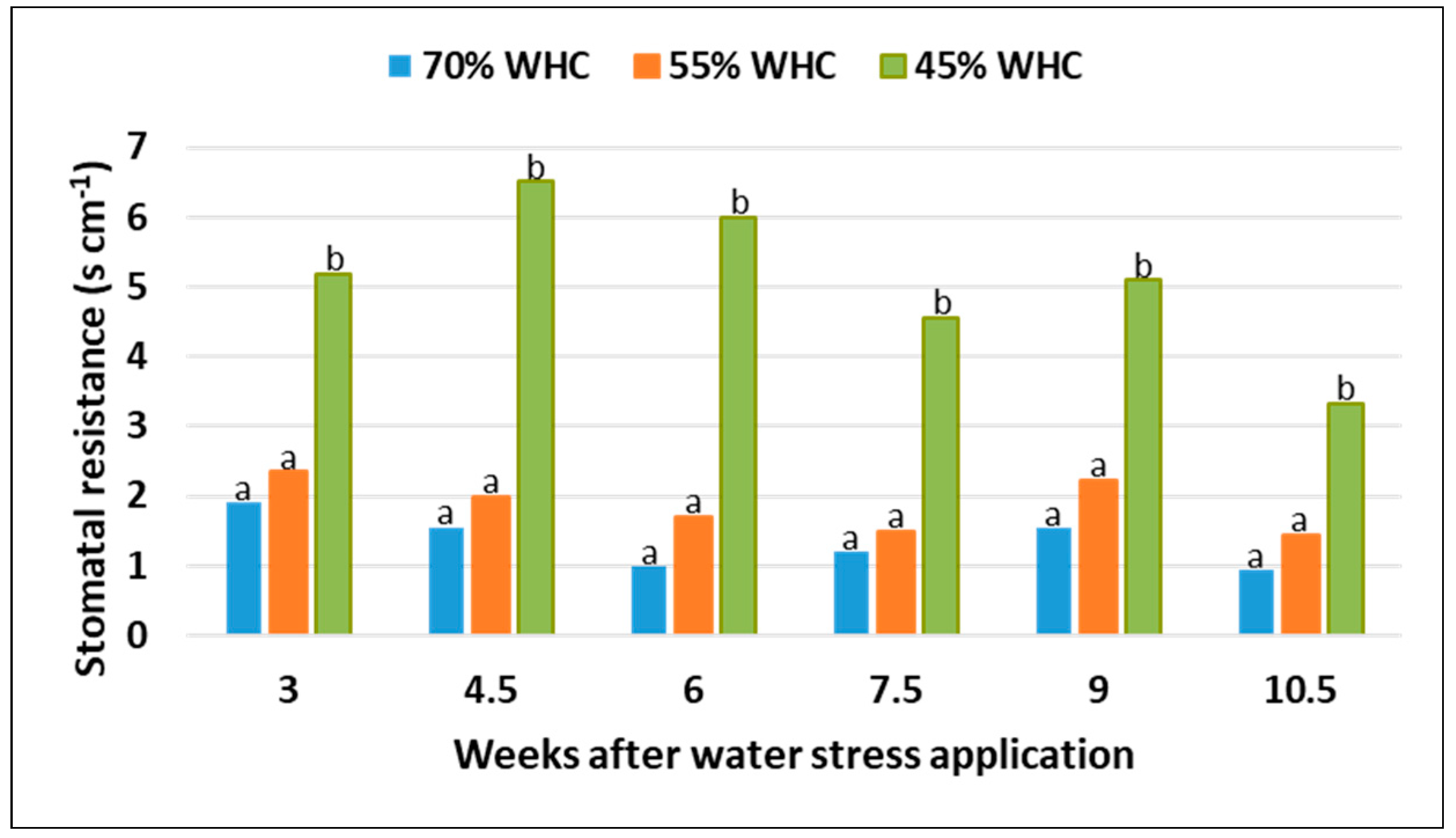
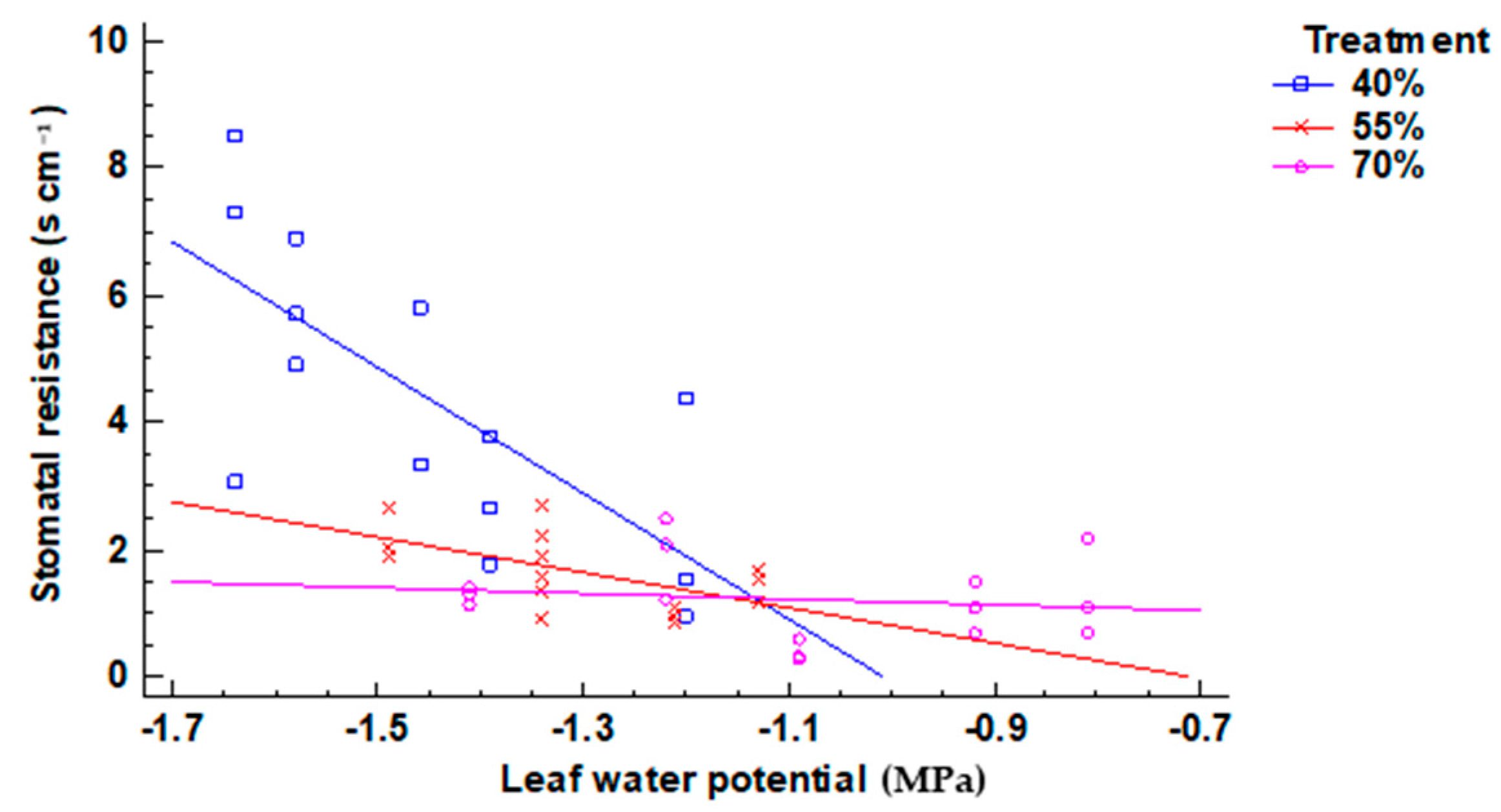
| Group of 15 Pots | Treatment | Pot Weight (kg) | Available Soil Moisture (%) |
|---|---|---|---|
| A | Well-watered/Control—T70 | 13.50 | 70 |
| B | Moderately stressed—T55 | 13.10 | 55 |
| C | Highly stressed—T40 | 12.70 | 40 |
| Stress Levels | Days after Water Stress Application | |||||
|---|---|---|---|---|---|---|
| 23 | 33 | 43 | 53 | 63 | 73 | |
| Control (70% ASM) | −1.23 | −1.08 | −0.93 | −0.83 | −1.39 | −1.10 |
| Low (55% ASM) | −1.34 | −1.27 | −1.35 | −1.14 | −1.49 | −1.23 |
| High (40% ASM) | −1.47 | −1.64 | −1.58 | −1.33 | −1.65 | −1.41 |
| Difference between T70 and T40 | −0.24 | −0.56 | −0.65 | −0.50 | −0.26 | −0.31 |
| Stress Levels | Time | ||||
|---|---|---|---|---|---|
| 6:30 | 9:00 | 11:30 | 14:00 | 16:30 | |
| Control (70% ASM) | −0.69 | −0.47 | −0.85 | −0.98 | −0.91 |
| Low (55% ASM) | −0.83 | −0.61 | −1.19 | −1.25 | −1.13 |
| High (40% ASM) | −1.15 | −1.23 | −1.46 | −1.37 | −1.35 |
| Stress Level | Linear Model | Pearson’s Correlation Coefficient | p-Value |
|---|---|---|---|
| T70 Control (70% ASM) | 0.00 | 0.9824 | |
| T55 Low (55% ASM) | −0.59 | 0.0207 | |
| T40 High (40% ASM) | −0.70 | 0.0034 |
Publisher’s Note: MDPI stays neutral with regard to jurisdictional claims in published maps and institutional affiliations. |
© 2020 by the authors. Licensee MDPI, Basel, Switzerland. This article is an open access article distributed under the terms and conditions of the Creative Commons Attribution (CC BY) license (http://creativecommons.org/licenses/by/4.0/).
Share and Cite
Papazoglou, E.G.; Alexopoulou, E.; Papadopoulos, G.K.; Economou-Antonaka, G. Tolerance to Drought and Water Stress Resistance Mechanism of Castor Bean. Agronomy 2020, 10, 1580. https://doi.org/10.3390/agronomy10101580
Papazoglou EG, Alexopoulou E, Papadopoulos GK, Economou-Antonaka G. Tolerance to Drought and Water Stress Resistance Mechanism of Castor Bean. Agronomy. 2020; 10(10):1580. https://doi.org/10.3390/agronomy10101580
Chicago/Turabian StylePapazoglou, Eleni G., Efthymia Alexopoulou, George K. Papadopoulos, and Garifalia Economou-Antonaka. 2020. "Tolerance to Drought and Water Stress Resistance Mechanism of Castor Bean" Agronomy 10, no. 10: 1580. https://doi.org/10.3390/agronomy10101580
APA StylePapazoglou, E. G., Alexopoulou, E., Papadopoulos, G. K., & Economou-Antonaka, G. (2020). Tolerance to Drought and Water Stress Resistance Mechanism of Castor Bean. Agronomy, 10(10), 1580. https://doi.org/10.3390/agronomy10101580





